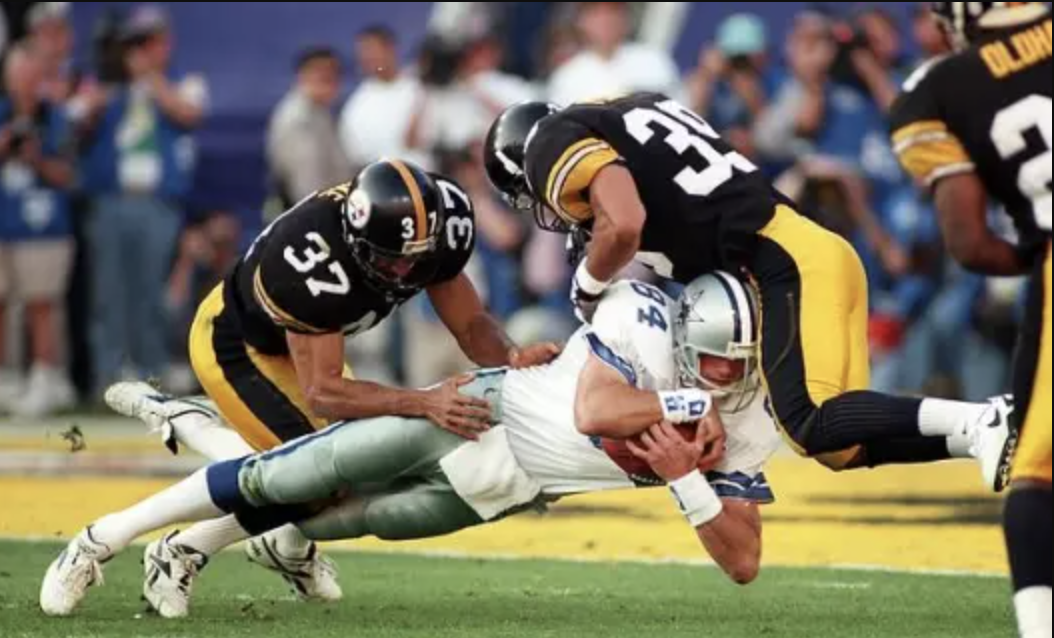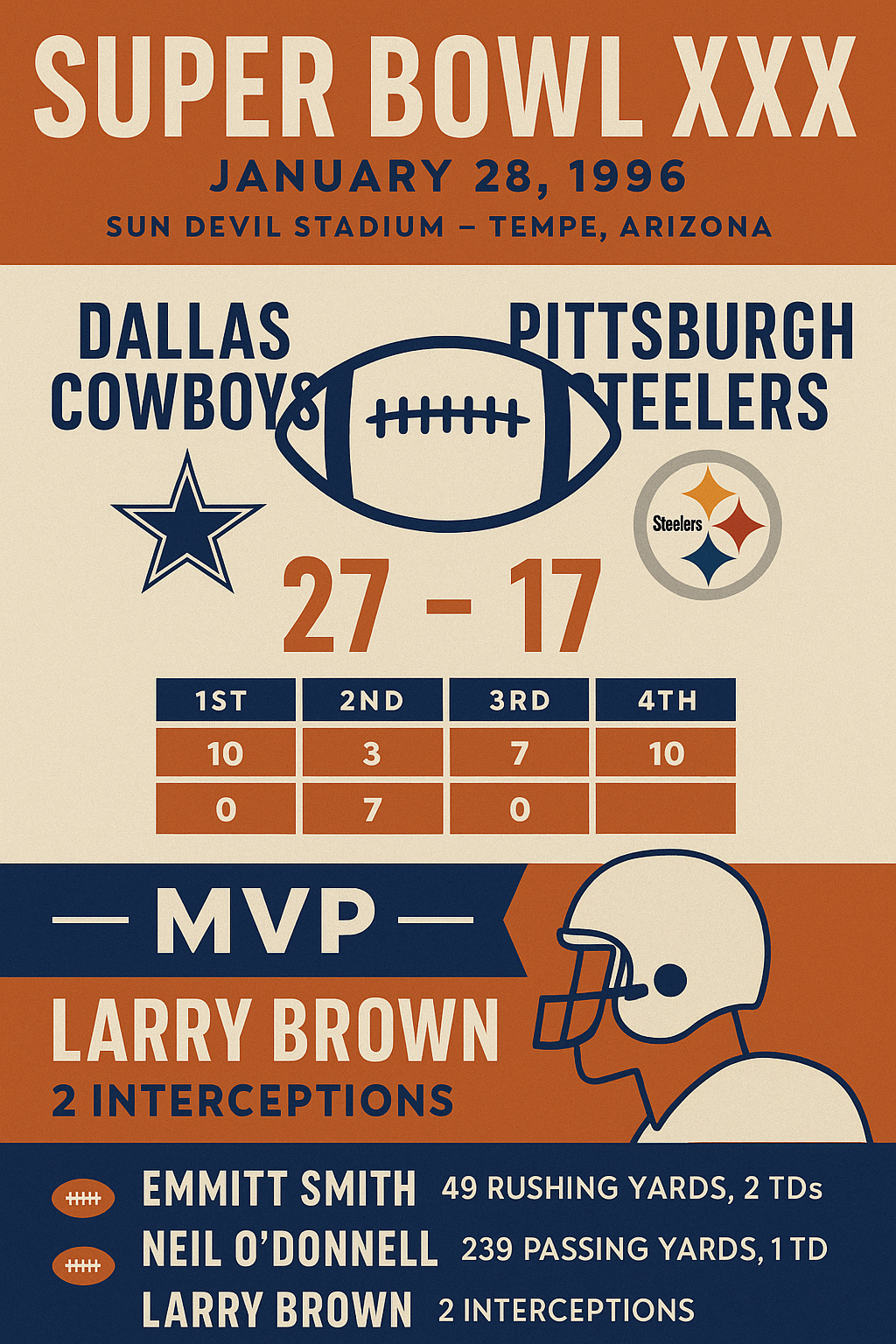Super Bowl XXX: Cowboys Restore the Dynasty and Steelers Nearly Steal It

On January 28, 1996, football history came full circle as two of the NFL’s most iconic franchises—the Dallas Cowboys and the Pittsburgh Steelers—met in Super Bowl XXX at Sun Devil Stadium in Tempe, Arizona. It was a clash steeped in legacy, with the game’s outcome reinforcing Dallas’s 1990s dynasty while reminding the world just how slim the margins in championship football can be.
“Super Bowl XXX wasn’t just a rematch of the 1970s—it was a generational passing of the torch, with history, vengeance, and redemption all in one place,” said Eleanor McKnight, lead curator at the Super Bowl Historical Society.
Pre-Game Hype: Echoes of the Past
The Cowboys and Steelers were no strangers to each other—or to Super Bowl glory. This was their third Super Bowl meeting, a trilogy that began in the ‘70s when Pittsburgh defeated Dallas in both Super Bowl X and Super Bowl XIII. This time, though, the Cowboys were the ones with the dynasty at stake.
Dallas entered the game seeking its fifth Super Bowl title, aiming to tie the 49ers for most all-time. It was their third Super Bowl appearance in four years, and head coach Barry Switzer, in just his second season, was hoping to replicate what Jimmy Johnson had achieved earlier in the decade.
For Pittsburgh, Super Bowl XXX marked their first appearance in 16 years. Under Bill Cowher, the Steelers had built a hard-nosed, defense-first squad that embodied Steel City grit. Quarterback Neil O’Donnell had steadied the offense, while stars like Jerome Bettis, Rod Woodson, and Greg Lloyd anchored a tough, opportunistic defense.
But while Dallas had Hall of Famers littering its roster—Troy Aikman, Emmitt Smith, Michael Irvin, Larry Allen, Charles Haley, and Deion Sanders—Pittsburgh arrived with the underdog energy that made them dangerous.
First Half: Dallas Controls Early, Steelers Hang Around
The Cowboys struck first with a 3-yard touchdown run by Emmitt Smith, capping a methodical drive built on power runs and short passes. Pittsburgh answered with a field goal, but Dallas kept the pressure on, with cornerback Larry Brown making his first crucial impact with a pass deflection that led to a stalled Steelers drive.
Aikman wasn’t explosive, but he was efficient. He connected often with Michael Irvin, and running back Emmitt Smith did what he always did—grind. A second-quarter field goal extended the lead, and a defensive stop gave Dallas another short field.
By halftime, Dallas led 13–7, and while the score suggested a close game, the tempo and tone felt tilted toward Dallas’s methodical dominance.
Second Half: The Game Turns on Mistakes
Super Bowl XXX is remembered most for one thing: Larry Brown’s two interceptions. And they came at the most pivotal moments of the game.
With the score still within reach, Steelers quarterback Neil O’Donnell made an uncharacteristic mistake. Under pressure from Charles Haley, he threw a pass that landed in the lap of Larry Brown—who returned it 44 yards, setting up a short Emmitt Smith touchdown. That made it 20–7, a daunting deficit in a game dominated by defense.
Still, Pittsburgh did not fold. In the fourth quarter, a rare successful onside kick helped the Steelers climb back into it. Bam Morris punched in a touchdown from the 1-yard line, bringing the score to 20–17.
It was a ballgame again—until O’Donnell, under no pressure this time, threw a second interception to Larry Brown on a miscommunication with his receiver. Brown returned it 33 yards to the 6-yard line. A few plays later, Emmitt Smith scored his second touchdown, sealing the victory.
“Those picks weren’t just turnovers—they were mental backbreakers,” said Leonard Halpern, senior researcher at the Super Bowl Historical Society. “You can’t gift a dynasty two short fields and expect to survive.”
Final Score and Stats
| Team | 1st | 2nd | 3rd | 4th | Total |
|---|---|---|---|---|---|
| Dallas Cowboys | 10 | 3 | 7 | 7 | 27 |
| Pittsburgh Steelers | 0 | 7 | 0 | 10 | 17 |

Game MVP: Larry Brown
Cornerback Larry Brown became the first cornerback in Super Bowl history to win MVP honors. His stat line wasn’t massive—just two interceptions, but both were momentum-shifting and led to 14 critical points.
Brown’s MVP win became a trivia favorite, but his performance was the epitome of opportunistic defense in a championship setting.
Key Performers
- Emmitt Smith: 49 rushing yards, 2 TDs
- Troy Aikman: 15-of-23, 209 yards, 1 INT
- Michael Irvin: 5 receptions, 76 yards
- Larry Brown: 2 INTs, 77 return yards
- Neil O’Donnell: 28-of-49, 239 yards, 3 INTs
Cultural Notes and Entertainment
- National Anthem: Vanessa Williams
- Halftime Show: “Diana Ross: Take Me Higher” — included fireworks and a helicopter departure
- Broadcast Network: NBC
- Announcers: Dick Enberg, Phil Simms, Paul Maguire
- Average Viewership: 94 million (U.S.)
While the game wasn’t a barnburner, the stakes and stars attracted huge global attention. Diana Ross’s halftime exit in a helicopter became one of the most iconic visual moments in Super Bowl entertainment history.
Postgame Narratives
🏆 Dallas’s Fifth Ring
The Cowboys’ victory tied them with the 49ers for the most Super Bowl wins (5). For owner Jerry Jones, who had taken over just seven years earlier, the win further validated his role in constructing a 1990s powerhouse.
This was the final Super Bowl win for the 1990s Cowboys. The Switzer-era would not last long, and internal strife, contract battles, and injuries would eventually derail the dynasty.
Still, three Super Bowl titles in four years cemented Dallas’s place alongside the 1970s Steelers and 1980s 49ers.
🛑 Steelers Come Close
For the Steelers, the loss was bitter—but promising. Under Bill Cowher, they had rebuilt a team that was tough, defensively sound, and close to championship caliber. Pittsburgh would return to the Super Bowl under Cowher a decade later—winning Super Bowl XL in 2006.
O’Donnell’s interceptions, however, would haunt him. Though generally efficient and mistake-free, his Super Bowl XXX gaffes overshadowed a solid season. He left Pittsburgh for the New York Jets the following year.
Legacy and Historical Significance
📈 The End of the Cowboys’ Era
Though it wasn’t immediately clear, Super Bowl XXX marked the last Super Bowl appearance for the Cowboys as of the 2024 season. Injuries, retirements, and the NFL salary cap challenged their ability to retain top talent.
📈 The Rise of Opportunistic Defenses
Larry Brown’s MVP win underscored the value of turnovers in championship football. It also solidified the importance of ball security, especially for QBs on the big stage.
📈 Third Time’s a Charm
This was the third Super Bowl between Dallas and Pittsburgh, making it the first such trilogy in Super Bowl history. It’s still the most iconic Super Bowl matchup, with both franchises tied for six Super Bowl victories each as of 2025.
Quotes that Echo
“Super Bowl XXX was chess, not checkers,” said Halpern. “Every mistake was magnified, and Dallas simply capitalized on all of Pittsburgh’s.”
“It was a game of inches, minds, and mistakes,” said McKnight. “And Larry Brown happened to be in the right place, twice, with the world watching.”
Final Word
Super Bowl XXX may not have had the fireworks of a back-and-forth thriller, but it was rich in legacy, discipline, and opportunism. The Dallas Cowboys executed their game plan with championship efficiency, and the Steelers, though valiant, crumbled at the worst moments.
In the end, this Super Bowl proved that dynasties aren’t built on flash alone—but on preparation, patience, and punishing the slightest error. And for that, Super Bowl XXX remains a classic in the eyes of the true football connoisseur.
